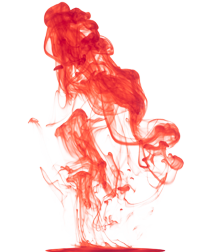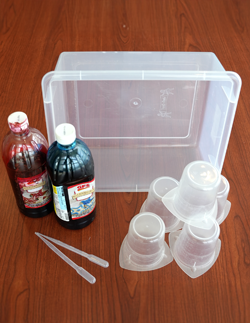Colorful Convection Currents
Observe how the process of convection works by using a few household items and hot water.
Fun Facts/Information

Convection is a process that transfers heat through movement of gases or liquids.
Many natural occurrences take place because of convection:
- Wind
- Ocean currents
- Shifting tectonic plates (resulting from movement of the earth’s mantle)
Learning Objectives:
- Investigate convection currents by using household materials to create and observe colorful fluid movement and how heat affects the motion of liquids.
Materials:
- Clear container (about 1 foot in length and 5 inches high)
- 5 identical sturdy cups (or sturdy cups with identical heights), one of which can hold hot water.
- Hot water
- Red and blue food coloring with openings that fit pipettes/droppers
- 2 Pipettes or other types of droppers (You can use 1 pipette/dropper, but make sure to rinse between using each food coloring.)

Safety Considerations:
- Wear plastic gloves, an apron, or an old T-shirt to prevent staining hands and clothes with food coloring.
- Be careful not to burn yourself with hot water when pouring or placing it beneath the clear container.
Procedures
- Fill the clear container with water (leave about an inch of space at the top) and let it sit out for as long as possible to ensure it reaches room temperature (It shouldn't feel too hot or cold).
- Arrange 4 of the 5 cups into a rectangular shape. These 4 cups will act as support so that you can place your clear container of room temperature water onto them.
- Gently place the clear container of room temperature water onto the cups so that the weight is evenly distributed and is stable (1 cup beneath each corner of the clear container).
- Fill a pipette/dropper with a pinky nail length of red food coloring.
- Submerge the tip of the pipette/dropper in the center of the clear container until it touches the bottom. Slowly squeeze the pipette/dropper to allow the red food coloring to form a puddle (about the size of a quarter) at the bottom center of the container.
- Rinse the pipette or grab another to fill with about a pinky nail length of blue food coloring.
- Submerge the tip of the pipette/dropper about an index finger length to the left and right of the red food coloring puddle, slowly squeezing out about a quarter sized puddle of the blue food coloring on each side.
- Pour hot water into the 5th cup and slide it under the center of the container where the red food coloring should be puddled.
- Sit back and watch the colorful convection current! The red simulates warm “water” or “air” rising. The blue represents the cold “air” or “water” rushing in to fill the space. Simulating what causes wind and ocean currents.ith hot water when pouring or placing it beneath the clear container.
Discussion Questions:
- What do you think causes a convection current to move
- Do you think hot or cold water rises to the top of the container during this demonstration?
Extensions
- Try creating another colorful convection current by making blue ice cubes (using blue food coloring) and placing one into a tub of room temperature water. Then gently introduce some hot water with red food coloring into the same tub of water on the opposite side.
Quick Links
Where are Activities Available?
We partner with over 600 educational organizations.
See our school locator